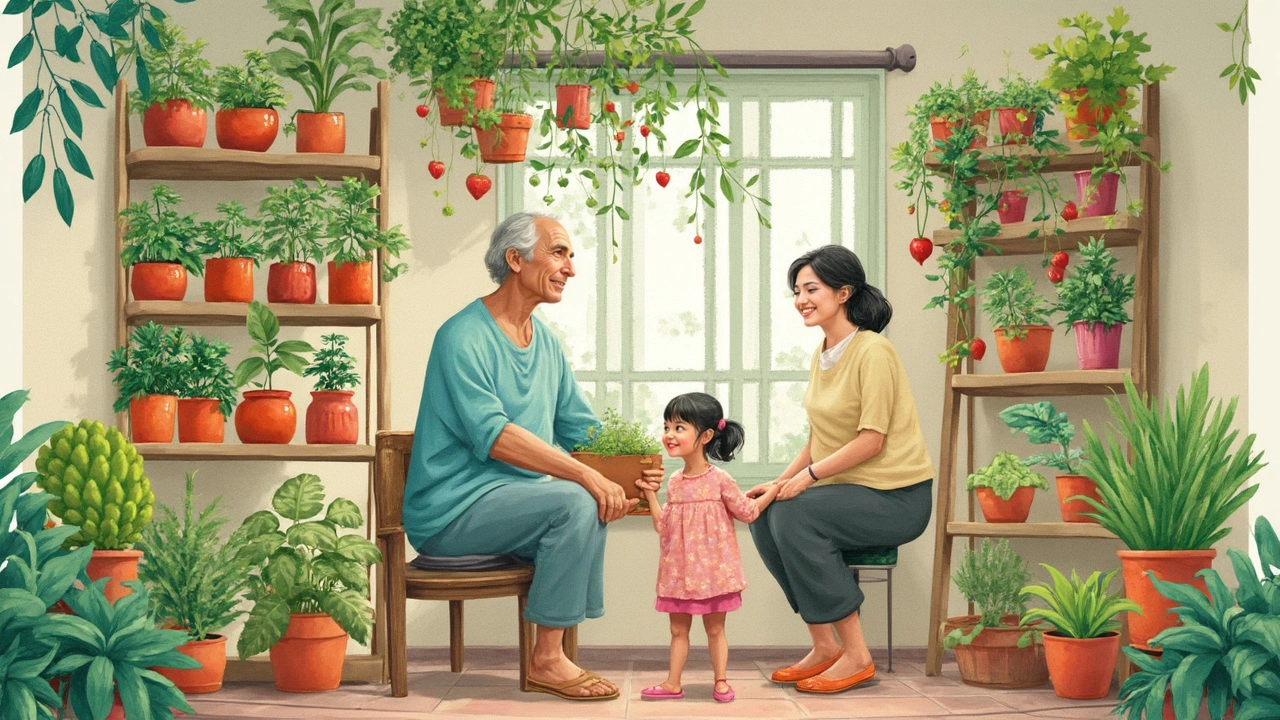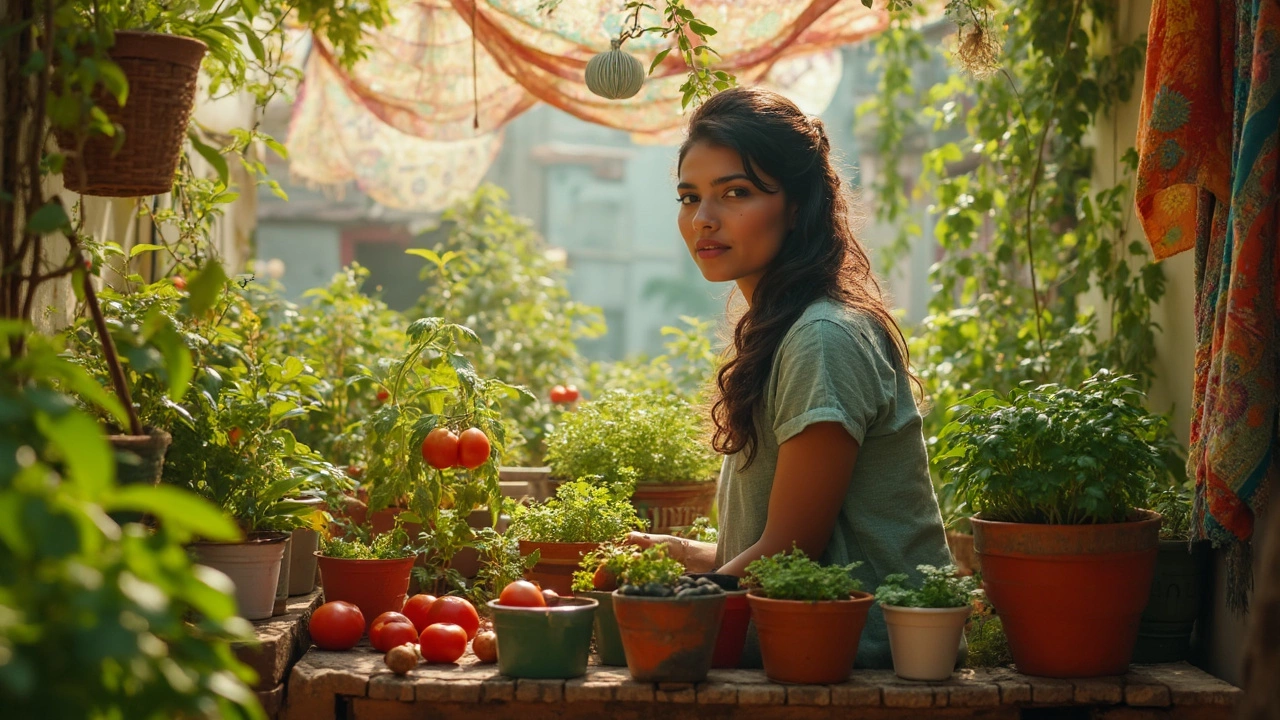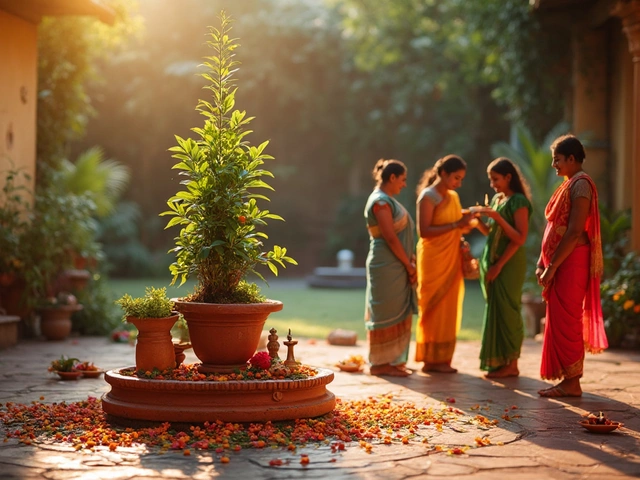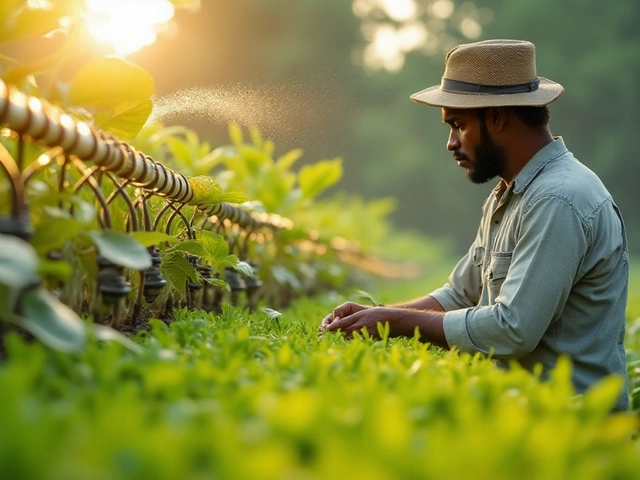Got a balcony and dreaming of fresh fruit and veggies, but not sure if it’s even possible? Good news: you don’t need much space—or even much experience—to pull off a decent harvest. The trick is picking the right plants. Some crops just don’t make sense up there (watermelon, anyone?), but plenty of others will surprise you.
Start by taking a good look at your balcony. How much sun does it get? Most veg and fruit need at least six hours a day. If you’ve got shade, don’t worry—there are still options, but your choices change a bit. Size matters too. You’ll need enough room for pots or containers, but you don’t need a rainforest setup. Some of the tastiest crops grow perfectly well in small tubs, hanging baskets, or even old buckets. Honestly, my dog Max hardly notices the difference—and he usually sniffs out everything.
- Balcony Basics: What You Can Actually Grow
- Top Fruits for Easy Balcony Harvests
- Veggies that Thrive in Small Spaces
- Tips for Success: From Pots to Pollinators
Balcony Basics: What You Can Actually Grow
When it comes to balcony gardening, you’ve got more options than you might think. The trick is knowing your space and picking plants that match. Most folks get the best results with leafy greens, herbs, small fruiting plants, and compact veggies. Forget about stuff like pumpkins or corn—those just take up too much space and need more soil than a pot can give.
Check your sun exposure. South and west-facing balconies get more hours—great for tomatoes, peppers, and strawberries. If you only get three or four hours of sun, go for things like lettuce, spinach, and some herbs. Some crops can even handle a shady spot, including mint and chives.
Before grabbing seeds or seedlings, consider these important things:
- Container size: Bigger pots mean bigger harvests, but you don’t need giant tubs for everything. Salad greens and radishes do fine in shallow containers, while tomatoes want something a bit deeper.
- Balcony strength: Wet soil and ceramic pots get heavy. Make sure your balcony can handle the weight.
- Watering needs: Small pots dry out real fast, especially on windy days. Expect to water more often than a regular garden.
- Wind protection: City balconies can be windy. Put taller plants near railings, or use screens to shield them.
- Drainage: Always pick pots with drainage holes or add a layer of pebbles at the bottom. Soggy roots mean dead plants.
Want a quick look at which fruit and veg fit the average balcony setup? Here’s a handy cheat sheet:
| Crop | Sun Needed | Best Container Depth |
|---|---|---|
| Strawberries | 6+ hours | 15-20 cm |
| Tomatoes (cherry or dwarf) | 6+ hours | 30 cm |
| Lettuce & Greens | 3-4 hours | 15 cm |
| Herbs (basil, parsley, mint) | 3+ hours | 10-15 cm |
| Radishes | 3-4 hours | 10 cm |
Bottom line: if your balcony gets some sun and you don’t mind a little daily care, you can grow a surprising amount of easy balcony crops. City living doesn’t have to mean giving up on home-grown flavor.
Top Fruits for Easy Balcony Harvests
When it comes to balcony gardening, most folks are shocked at how many fruits do well in containers. You just need the right type and a bit of sun. Here are some tried-and-true favorites that actually produce, not just look pretty.
- Strawberries – These guys love balcony life. Go for everbearing or alpine varieties. They do well in hanging baskets or narrow troughs. You get fresh berries all summer, and it's almost impossible not to snack as you water them.
- Blueberries – Pick a compact variety like Top Hat or Jelly Bean. They need acidic soil (look for compost clearly labeled for ericaceous plants). One cool fact: Just two small bushes can give you almost a kilo of berries per season in a big pot. Bonus, the plant turns a bright red in autumn.
- Dwarf citrus trees – Lemons and limes in pots jazz up any balcony and can be moved indoors for winter in cold spots. Try 'Meyer' lemons or calamondin oranges for the best results in small spaces. Give them extra light if your spot is shady.
- Figs – Tiny fig trees love containers since the roots stay in check. The plant won’t take over, and you’ll get a nice handful of soft, sweet figs by late summer. Choose a self-fertile type such as ‘Little Miss Figgy’ or ‘Petite Negra’.
- Raspberries – Go for dwarf berries like ‘Ruby Beauty’. They reach only about a meter high and give you tasty fruit in midsummer. Unlike regular raspberries, these don’t need staking or a big patch of earth.
If you like facts, check this out—the best fruit to grow on balconies all tend to mature quickly and rarely need pollinators. Some, like strawberries, can start giving you fruit in as little as eight weeks from planting plugs.
| Fruit | Container Size | Sun Required |
|---|---|---|
| Strawberries | Hanging basket or 3L pot | 6+ hours/day |
| Blueberries | 30cm wide/deep pot | 6+ hours/day |
| Dwarf Citrus | Minimum 40L pot | 8+ hours/day |
| Figs | 30cm pot minimum | 6+ hours/day |
| Raspberries | 25-30cm pot | 6+ hours/day |
Keep in mind—consistent watering is your main job. Balconies get hot and dry, so fruit in containers need a good soak more often than garden plants, especially in summer. A cheap water meter from the hardware store can save you from over- or under-watering, which is the #1 way container fruit goes wrong.

Veggies that Thrive in Small Spaces
You don’t need a sprawling garden to get a solid veggie harvest. Plenty of veggies are almost made for balcony gardening—they’re compact, quick to grow, and don’t mind a pot. The right choices mean less hassle and more snacks. Here’s where to start if you want success and don’t want to waste time and effort.
- Leafy greens: Lettuce, spinach, and arugula are the speed demons of the small space garden world. They grow fast, don’t get too tall, and keep giving if you pick the outer leaves and let the center keep growing. A single window box can do the trick, and you’ll start nibbling in a few weeks.
- Radishes: This one’s for the impatient. Radishes are legendary for their speed—sometimes ready in three weeks. They love a wide, shallow pot and you can fit a lot in a small area. Bonus: You can eat their leafy tops too.
- Carrots (short varieties): Going for a deep container? Small, round carrots (“Paris Market” or “Thumbelina”) are made for balcony gardening. They tolerate containers and you don’t need perfect soil.
- Chili peppers and dwarf bush beans: If your balcony gets lots of sun, chili peppers and bush beans will reward you with bright, regular harvests. The bush type beans take less space than climbers and don’t need much support.
- Herbs: Basil, chives, parsley, and cilantro are crazy easy. Even if you forget to water sometimes, most pull through. Plus, you get fresh toppings for everything—no more lame dried herbs on your pizza.
Size of container matters, but not as much as you’d think. Leafy stuff needs shallower pots (about 15cm deep), while carrots need something a bit deeper. Drainage holes are mandatory unless you want a moldy disaster.
| Veggie | Container Depth | Light Needs | Harvest Time |
|---|---|---|---|
| Lettuce | 15 cm | Partial to full sun | 3-4 weeks |
| Radish | 12 cm | Full sun | 3-4 weeks |
| Carrots (small types) | 20 cm | Full sun | 8-10 weeks |
| Chili Peppers | 20 cm | Full sun | 10-12 weeks |
| Basil/Herbs | 15 cm | Partial to full sun | 4-6 weeks |
If you’re tight on horizontal space, go vertical. Stackable pots or hanging planters let you fit way more. Plus, greens and herbs don’t need deep soil, so you can get creative. Just make sure your plants get enough sunlight and don’t dry out—balconies can get windy, so check soil moisture often. The more you pick, the more you get, so harvest small amounts often and keep your plants working for you.
Tips for Success: From Pots to Pollinators
It’s easy to overlook some of the small stuff when you’re starting a balcony gardening setup, but the difference between a thriving mini-jungle and a bunch of sad, wilted twigs usually comes down to a few basics. Let’s break down what actually works.
- Pick the right pots. Go for containers with drainage holes—plastic, terracotta, or even buckets work. Bigger pots mean roots can spread out more, and the soil won’t dry out so fast in summer heat.
- Use quality soil. Skip the cheap stuff. Potting mix made for veggies has all the right nutrients and drains better than what you’d scoop off the sidewalk. Add slow-release fertilizer or a weekly feed to keep your plants happy.
- Keep it watered (but not drowned). Balconies can get windy, which dries out soil quick. The fingertip test works: poke the top inch of dirt, and if it’s dry, water. Tomatoes and strawberries—some of the best fruit to grow on a balcony—get dramatic if you let them dry out, so keep tabs daily in the heat.
- Maximize the sunlight. Position your easy balcony crops so each gets as much light as possible. Rotate pots every week to even out growth if the sun mostly hits just one side.
- Give your veggies support. Peas, beans, and even cherry tomatoes need a little help. Cheap wooden stakes, old coat hangers, or a trellis can make a big difference.
One more thing lots of people miss—pollinators. Balconies can be a little high for bees and butterflies. For crops like tomatoes and peppers, just give the flowers a gentle shake to help spread pollen. Or, grab a cotton swab and act like a bee, dabbing from flower to flower. It actually works and makes a huge boost in yield.
Here’s a quick cheat sheet on basic care, with real numbers:
| Crop | Pot Size (Liters) | Sun Needed (Hours) | Watering (per week) |
|---|---|---|---|
| Tomatoes | 10-15 | 6-8 | 3-5 |
| Leafy greens | 5-8 | 3-5 | 2-4 |
| Strawberries | 4-6 | 5-7 | 2-4 |
The real secret to great small space garden results comes down to attention—you don’t need a green thumb, just a routine. Check your plants while sipping your morning coffee, water before work, give things a prod and poke. Before long, you’ll be harvesting more than you can eat (and maybe even sharing with your dog—or, in my case, Max just sniffs and walks off).





